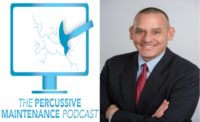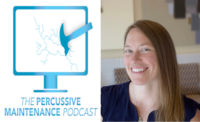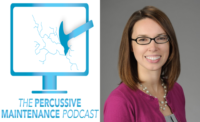Michael Frank, vice president of engineering at McKinstry, recently sat in for an episode of the Percussive Maintenance podcast to discuss the firm’s reaction to the COVID-19 pandemic as well as its “Return with Confidence” service. Click the play button below to listen to the podcast episode and/or read the transcript below.
Engineered Systems: Michael, welcome to the podcast. Could please introduce yourself for our listeners?
Michael Frank: Thanks for having me. My name is Michael Frank. I'm vice president of Engineering at McKinstry. We're a design-build organization with offices nationwide, and I lead a team of about 100 engineers, mechanical, electrical, plumbing, structural — you name it — we design it in terms of the built environment.
ES: Well, strange times right now plague our country, as we're several months deep into this COVID-19 pandemic. Can you update us on how McKinstry is handling this pandemic? Is the firm running at full strength? Do you have engineers that are still working from home?
Frank: We're handling the pandemic really well. Our leadership team reacted really quickly. We formed a task force making decisions to keep our employees safe. We were one of the first companies to require people to work from home and we’re restricting travel. Some of our job sites shut down very early on, although we're also working on potential projects by our local government agencies. At this point, we are ramped up to full capacity on the construction side from the engineering side. We are allowing everybody to work from home as long as they want. We want to make sure everyone feels comfortable before they come back to the office, although we offer a voluntary return. You know, our workplace is actually trying to act like a job site. So, we're requiring face coverings, physical distancing, and a lot of sanitary practices. We’re anticipating our employees will continue to work from home for quite some time.
ES: So, as America continues its quest to reopen. McKinstry has introduced a program called, “Return with Confidence.” This service is designed to help prepare buildings for a safe reopening. Can you give us some background on the service?
Frank: Absolutely. A lot of our clients were quick to shut down their systems and buildings, which have sat empty or unoccupied for the last several months now. A lot of customers have never had to restart those systems before. They’ve always operated in occupied or unoccupied mode. So, this is unchartered territory. We recognize we need to help our clients create a healthier environment for all of their employees, so we put this plan together. There's obviously a number of considerations to take when restarting an HVAC and plumbing systems to make sure that they don't harm occupants and that facility managers are doing as much as they can to actually keep occupants safe. HVAC systems obviously play a key role in lowering risk of infectious disease. The solution to pollution has evolved since grade school. One area that a lot of our building owners and facility managers don't think about is the water system. And if it hasn't been running for quite some time there’s some risk domestic systems as well as cooling tower systems, either from a Legionella perspective on the water side among other concerns.
ES: Can you dig a little deeper and describe some of the exact services that you guys will be offering during these “Return with Confidence” visits?
Frank: For sure. Usually it starts with a conversation to understand if the building owner needs an in-person assessment or a more in-depth assessment. Then we assign someone to actually review those systems more in depth. We've got a number of things that we'll be checking. After that assessment, we typically develop an action plan that targets an individual building’s needs, with a focus on what needs to be done to get that building reopened. Then, we work with the customer to see if and how we can help them with those tasks.
ES: Of course, this service relies on the guidance of ASHRAE. What other standards or codes does McKinstry reference when you're on these visits?
Frank: There's CDC guidelines that really get into water systems and Legionella concerns as well as mold concerns from, you know, we don't necessarily have to worry too much about that in the northwest, but in a lot of other locations, if you have a building that’s unconditioned, we have to take a look at that as well. So, the CDC covers mold and Legionella and REHVA [the Federation of European Heating, Ventilation, and Air Conditioning Associations] has a lot of really good plumbing and HVAC guidelines. And, ASHRAE, like you mentioned, actually has some interesting guidelines as well in terms of returning to work and how to work with your employees on travel requirements, what you should do if you're heading outside for meetings, and how to handle contact tracing. So there are a lot of national and international organizations that have been pulling together to offer documentation to help building owners try to get to a point where they feel good about reopening their facilities.
ES: McKinstry is blessed with licensed technicians, plumbers, and electricians – it’s a big firm. This allows you to deliver comprehensive MEP services. Talk about how the breadth of your firm and how that allows you to deliver such a comprehensive service.
Frank: We've developed a platform that allows us to provide mechanical, electrical, plumbing, and piping services at all stages of the building life cycle. As I mentioned earlier, we’re a design- build, operate, and maintain organization and having that expertise across all of the disciplines — whether it be construction, engineering, maintenance and service or building energy efficiency — we're able to provide a unique insight into how to optimally operate building systems.
ES: What are some of the typical outcomes or recommendations that a building owner may hear through this service?
Frank: It varies on the owner and the type of system they've got. Some of the things we're looking at, on the HVAC side, is filtration methodology, equipment that delivers outside air, the amount of outside air being brought in, the air change rate, how facilities are zoned, etc. We also take a deeper dive into highly populated areas, like restaurants, cafeterias, gymnasiums, school environments, where you might want to pay a little bit more attention to individual items. Also, if the space operates 24/7, the recommendations will differ. We may recommend that you don't close your outside air dampers. On the a/c side, those are the types of things we look at. And then, on the water side, you know flushing systems and developing a water management plan are two things that will typically help your customers through this process.
ES: Is this a regional service or is it available nationwide?
The assessment and action plans are in development and are available in all our locations. Now, we’re not active in every state, but it’s available where we are.
ES: So, in reopening, let's assume a building owner or facility manager opts to skip a service such as this. What type of dangers exists when they decided to go down that path?
Frank: This is such a hard question to answer because every building, as you imagine, is unique in terms of the systems on-site. Engineering and operations staff must be able to carry out some of these things and maintain them. We really operate on the side of caution and recommend exploring all options to ensure the health and safety of building occupants.
ES: Facility managers are certainly looking for this kind of guidance, so this is an exciting service. While we have you on the line, is there anything else that you want to mention?
Frank: I think we talked a lot about our services, but one thing I think is critically important is as you start to plan to bring people back to the office in a very safe manner and, obviously, you’re probably not going to be at full capacity, I recommend using some type of dashboard to help your customers, and the occupants of their buildings, understand what we're expecting of them and how they can play such an important role. A lot of buildings we work in have some type of energy dashboard, because that has been and continues to be such a hot topic, though pivoting some of those dashboards to cover safety and focus on what your role as an individual employee is and can be is another thing that should be heavily considered.
ES: Michael, if listeners are interested in connecting with you, or McKinstry, where should they turn?
Frank: They can go to www.mckinstry.com and search for return with confidence. You can also email us at together@mckinstry.com or call us on a dedicated hotline at 855-936-2554.
ES: We thank you so much for spending a few minutes with us today and we look forward to chatting with you again soon. Thank you!




